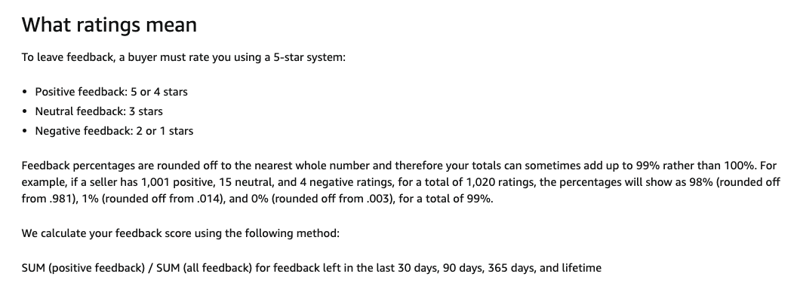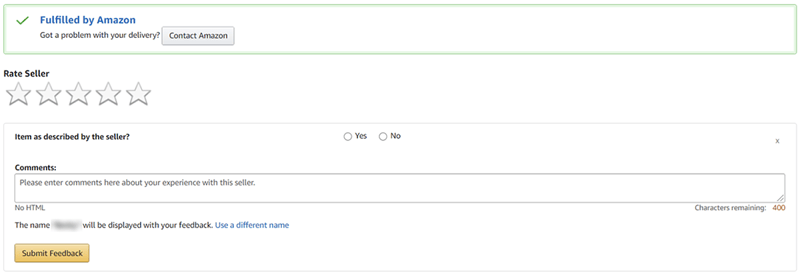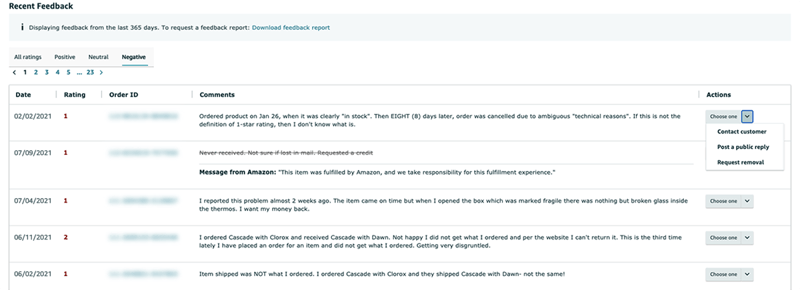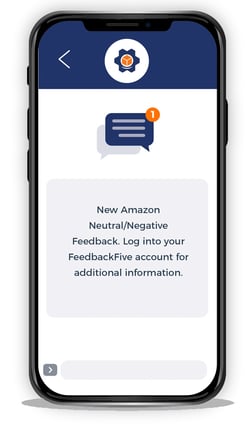Originally published on December 9, 2020, updated September 1, 2023
Menu
Join Our Email List
- Receive our monthly newsletter.
- Stay up to date on Amazon policies.
- Get tips to grow your business.
Are you up to date with Amazon feedback removal guidelines? You should be! This is something that’s bound to come up as your Amazon business grows if it hasn’t already.
Soliciting feedback for anything can be intimidating, especially nowadays when everyone airs their opinions so publicly. It may seem like you’re asking for trouble. But for many third-party seller platforms, acquiring customer feedback is encouraged and a key part of your selling strategy. In the Amazon world, in particular, good product reviews and seller feedback can make or break your business.
But what happens when a negative rating comes in (and it inevitably will!)? As you fret about the impact on your sales and account health, you may feel like your hands are tied. Don’t worry, you do have some options - especially if you feel that the rating isn’t in line with certain Amazon policies.
But before we dig too deep into those all-important guidelines, let’s first get a better idea of what Amazon seller feedback is and why the heck it matters so much.
Amazon feedback rates your performance as a seller on a scale of one to five stars. It helps Amazon shoppers learn more about each other’s buying experiences, specifically when it comes to product packaging, shipping, customer service, and seller professionalism.
Buyers have 90 days to submit one feedback response per order. Amazon calculates your seller rating based on averages of previous feedback obtained and displays it both as a star rating and as a percentage.

Many people use the terms feedback and reviews interchangeably, but they’re not the same. Think of Amazon feedback vs. reviews this way: feedback is a rating based on a buyer’s experience with the merchant, while reviews (or product feedback) should only refer to a buyer’s experience with the actual item being sold.
You can track your seller feedback using the Amazon Feedback Manager tool, which is located on the Feedback page underneath the Performance tab in your Seller Central dashboard.
Amazon Feedback Manager has two tables for viewing your metrics and feedback entries. The Feedback Rating table displays your feedback rating for the past 12 months along with your percentages and feedback for the last 30 days, 90 days, 365 days, and lifetime. The Recent Feedback table is organized by when feedback was received and shows the actual feedback entry with its associated order ID and rating. You can take a few key actions here, including requesting the removal of feedback, which we'll discuss a bit later.
Buyers can leave feedback by visiting this Amazon feedback link or going to their Order Details page. They’re asked to provide an overall rating for you as the seller and answer a few predefined questions about the order:
Buyers are also asked to leave comments about their experience with you, NOT the product. While some customers always seem to ignore this instruction, Amazon will often remove feedback exclusively about the product rather than the seller (more on that later). Comments will appear on your Seller Profile page along with your feedback score and star rating.
Amazon changes the format for these questions depending on your type of order fulfillment. Check out this example of what a buyer sees when leaving feedback for an order that was fulfilled by Amazon:

Now look at one for an order that was fulfilled by a merchant:

As you can see, there are fewer questions for an FBA order while the questions are more detailed for FBM orders.
Everything Amazon does is for the sake of its customer experience because it knows that’s what keeps people coming back. So as a seller, if you can’t provide that world-class experience Amazon covets so much, you probably won’t last very long. It’s that simple - and serious. Amazon only wants merchants that buyers can trust, and seller feedback is an easy way to measure buyer experiences with a seller.
For sellers, feedback does the following:
Affects Buy Box ownership. Seller feedback is a key factor for your Order Defect Rate, which is a heavily weighted metric in Amazon’s Buy Box algorithm. When it comes down to it, having more positive feedback compared to a competitor can help you win the Buy Box more often.
Looking for a quick way to track your Buy Box activity?eComEngine's Buy Box alerts notify you of vital Buy Box changes, including when your ASINs have won it, lost it, or had their Buy Boxes be suppressed by Amazon.
Has “Other Sellers on Amazon” implications. If buyers bypass the Buy Box and compare “Other Sellers on Amazon,” they will see your feedback rating here and most likely opt for the seller with the highest rating.
Gives sellers a competitive advantage. Today’s Amazon shoppers are incredibly review savvy and often use ratings to make purchasing decisions. Seller feedback is a review of your reputation, and nobody wants a bad reputation, right? Poor feedback can send a shopper straight to your competitor. And with upwards of 175,000 new sellers on Amazon in 2020 alone, competition continues to be high!
Can impact your account status. Amazon pays close attention to your Order Defect Rate and currently requires it to be less than 1%. If your rating goes above this key performance metric, Amazon could strip your seller privileges. Positive feedback helps protect your seller account.
These are some of the biggies, but there's more. Seller feedback has a trickle-down effect that can be felt far and wide across your account - for better or for worse. It’s vital that you take it seriously (Amazon certainly does!) and be as informed as possible about this subject.
Imagine one day you make a sale and then see that some feedback has come in. Great! Or, maybe not. This is when knowing the Amazon feedback removal guidelines comes in handy. Being familiar with them helps you act quickly!
You have two ways to submit an Amazon feedback removal request:
Amazon says it will not remove buyer feedback “even if it’s unwarranted or the issue has been resolved.” However, Amazon does recognize there are certain situations that call for the complete removal or further explanation of some types of feedback.
Amazon will remove feedback in these instances:
Amazon doesn’t always automatically remove these types of feedback, so be prepared to request feedback removal yourself. Note that if the comment includes a product review AND some feedback about your service, Amazon won’t remove it.
Amazon may strike through comments in these situations:
Another important note: If you’re an FBM seller (Fulfillment by Merchant), any negative feedback about the delivery experience, including the product condition and shipping, won’t be removed since you’re responsible for it all.

If your request is approved by Amazon, the feedback won’t impact your overall feedback score and ODR. Shoppers will see strike-through comments on your seller feedback page.
As a seller, you can only request feedback removal through the Amazon Feedback Manager within 90 days of the submission. Anything after that will be blocked. So, if you see something that's not in line with the Amazon feedback removal guidelines, you definitely don’t want to delay!
To request the removal of feedback in Amazon Feedback Manager, go to the Recent Feedback table and find the specific Order ID. Select Request Removal under the Actions column.

The Recent Feedback table makes it easy to sort your positive, neutral, and negative ratings and see all buyer comments. The Actions column also allows you to post a public reply on Amazon or contact the customer directly about the order.
Negative or incorrect feedback is bound to happen at some point. It’s a natural part of the Amazon ecosystem. When the time comes, it’s imperative that you know what to do! And while you can always manually monitor your feedback in Seller Central, you can also easily automate the process with eComEngine’s FeedbackFive software.
 This powerful tool allows you to automate requests for new seller feedback AND product ratings. Remember, they're not the same! FeedbackFive also alerts you via text and/or email when you receive ratings.
This powerful tool allows you to automate requests for new seller feedback AND product ratings. Remember, they're not the same! FeedbackFive also alerts you via text and/or email when you receive ratings.
Using software like FeedbackFive to get alerts for negative feedback makes it much easier to keep track of everything. You can even include notes in FeedbackFive to quickly reference when you requested an Amazon feedback removal request. Get started today to save time and increase your seller feedback!
Originally published on December 9, 2020, updated September 1, 2023
This post is accurate as of the date of publication. Some features and information may have changed due to product updates or Amazon policy changes.
These Stories on Feedback and Reviews
14321 Winter Breeze Drive
Suite 121 Midlothian, VA 23113
Call us: 800-757-6840





Copyright© 2007-2025 eComEngine, LLC. All Rights Reserved. eComEngine®, FeedbackFive®, RestockPro®, and SellerPulse® are trademarks or registered trademarks of eComEngine, LLC. Amazon's trademark is used under license from Amazon.com, Inc. or its affiliates.
Comments (1)